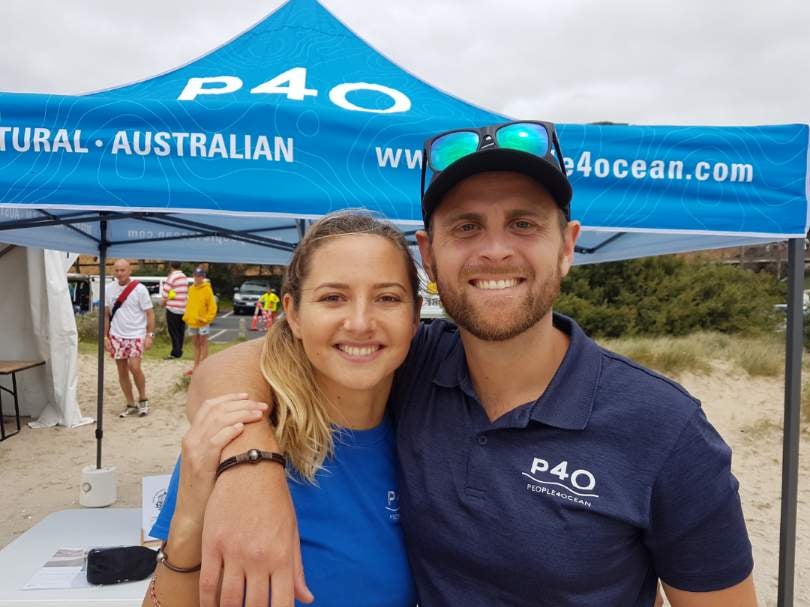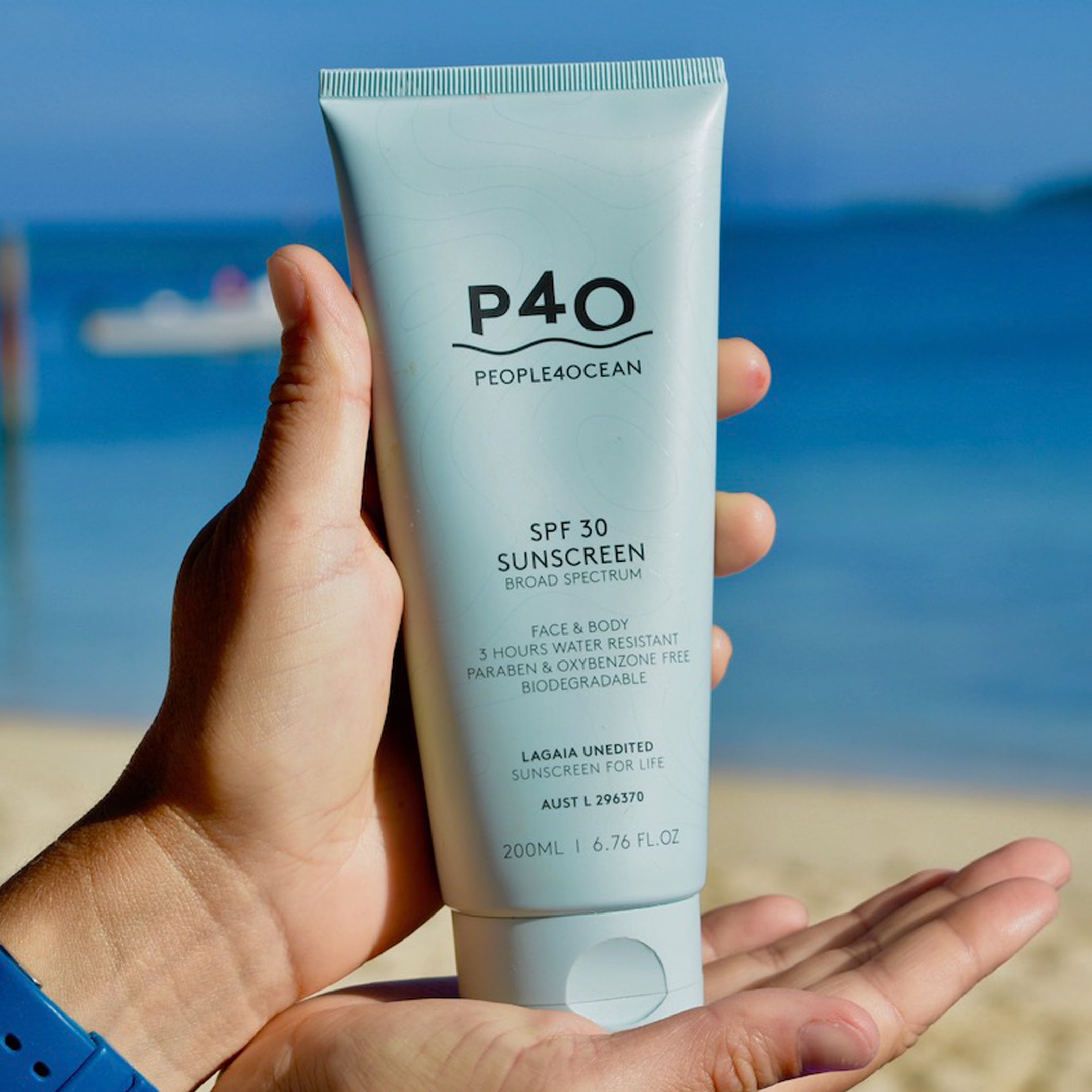The eco-friendly sunscreen makers helping to save ocean life
The couple behind Australian firm People4Ocean Sun Care are on a mission to protect coral reefs with their toxic-free sunblock. Andy Martin meets them


The weird thing is I had already slapped on some SPF 50 sunblock (not one of theirs) before I spoke to Louise and Austin Laing in Melbourne. “It’s the best anti-ageing product you can put on your skin,” says Louise. “You should do it every day.” “But have you checked the back of the bottle?” asks Austin. “It’s what we call the ‘conscious consumer’ – when you turn the bottle around and look at the contents. I bet it has oxybenzone in it. They nearly all do. It’s toxic to aquatic life.” Before speaking to the Laings, founders of People4Ocean (P4O) Sun Care, I must have been an unconscious consumer, because I hadn’t realised my (fairly expensive) sunblock could be toxic to anything – and I hadn’t checked the back of the bottle either. But they have come up with a product where you won’t even need to check the ingredients – they’re all ethical, safe and won’t poison the dolphins and turtles – or you.
I’ve got to admit, I also had no idea, before talking to them, that sunscreen typically works by converting UV rays into infra-red. Which sounds OK except for two things. One is you are liable to get hot skin. And the other is that the sunscreen is absorbed into your epidermis and from there into your bloodstream. So whatever you put on your skin eventually ends up getting pumped around every organ in your body. “It’s been shown,” says Austin, “that it’s detectable in your urine within twenty minutes of putting it on your skin.” The disturbing truth is that certain types of sunscreen can actually be more carcinogenic than the sun it’s protecting you from (and they’re already not recommended for pregnant or breastfeeding women or children under two).
Read More:
Australia, as Louise points out, is “the capital of skin cancer. Most Australians have fair skin, with no melanin. But geographically we are the most exposed to UV rays.” Sunscreen is so essential in Australia it attracts zero sales tax to encourage people to wear it. It also has the strictest SPF (Sun Protection Factor) ratings: US 30 is Australian 15.
Louise has a glowing skin with, she tells me, freckles and beauty spots. Her parents are French and she retains the trace of a French accent. She was born in Abu Dhabi but brought up in Maritius and spent all her time as a kid on the beach or in the water. She took a degree in biology and oceanography in Valencia before studying for a master’s in marine sciences at James Cook University in Townsville, Queensland, one of the top marine universities in the world. Which is where she met Austin.
His parents are American and he was born in Detroit but they moved to Australia when he was only six months old – where he became a swimmer and a surfer. “So many of us live on the coast, surfing is like the national culture. Surfers are starting to become conscious consumers.” He did his first degree in zoology in New Zealand before coming back to Australia to do further research. The romance between Louise and Austin began in oceanography class in 2012 and blossomed among the dolphins of Port Philip Bay, which they were monitoring.
Corals have to deal with so much: climate change, overfishing, pollution – they shouldn’t have to deal with sunscreen too
They went to the Seychelles to work on reef restoration and regeneration in 2016. As we have all known since the end of the last century, coral reefs are a technicolour metropolis of marine life but with higher water temperatures are subject to “bleaching” when the coral either dies or goes into retreat. The Laings transplanted 24,000 more heat-resistant corals – or “supercorals” – by hand over an area the size of a football field.
They also had to fend off “predators”. When corals are hit by a bleaching event, the predators move in to finish off the survivors. And the worst predators are not great white sharks but snails the size of your fingernail which like to eat coral. Keen gardeners will not be surprised to learn that snails can be just as much of a pest underwater when you are coral gardening. The Laings picked them out of the corals one by one using tweezers and shoved them in a bucket. It was either them or the corals.
All this time Austin and Louise had been wearing sunscreen on their faces – they didn’t need it on the rest of their bodies because they were mainly wearing wetsuits and oxygen tanks. But then they came across a groundbreaking study from the University of Hawaii that showed that many of the typical ingredients of sunscreen – oxybenzone, avobenzone, octinoxate and others – were pollutants and were liable to have an impact on coral reefs. “It was a real trauma for us,” says Louise. “We realised that we could be wearing a sunscreen that was harming the very corals we were trying to protect. We were handling corals every day, touching them. We knew that chemicals were bad for corals.”

Louise was wearing a French brand of sunscreen, which was not cheap, but that turned out (along with 97 per cent of all brands) to have that killer chemical cocktail in. Traces of these chemicals can be found in breastmilk and the placenta of dolphins. “It’s insidious,” says Austin. “After 40 or 50 years of sunscreen, these chemicals are present everywhere. They’re hormone destructors and they affect reefs in the same way, making them more susceptible to bleaching. The coral larvae are paralysed and can’t swim.”
They realised they had to do something about it. They had one great advantage: Austin’s mother worked in the cosmetics industry so they were backed by LaGaia Unedited. After a lot of testing and trialling in the Seychelles, within two years they had come up with a radical new alternative, which became the foundation of P4O: chemical-free non-toxic sunscreen that is better for your skin and so much better for corals and every other marine creature. They launched in Australia in 2018 and in January they released in the UK too. The big difference in the Laings’ approach is the use of mineral particles that sit on top of your skin and turn it from blotting paper into a mirror that reflects back those harmful rays.
Read More:
P4O have gone far beyond the original Hawaii study and have eliminated 14 potential contaminants. “You have to take everything out: you can’t just replace one or two chemicals,” says Austin. “Corals have to deal with so much,” says Louise. “Climate change, overfishing, dynamite, agricultural pollution – they shouldn’t have to deal with sunscreen too.”
The P4O formulation, zinc oxide combined with shea butter, grape seed and carrot seed oil, really is reef-safe (and vegan-friendly) and the winner of an Australian Non-Toxic Award in 2020. But Austin Laing warns the conscious consumer to look askance at the “reef-safe” label that is to be found on so many skin products. “Only trust the ingredients,” he says. “Don’t trust the marketing messages.” P4O is not just reef-safe, it’s reef-saving: for every tube of sunscreen you buy they donate $1 to programmes around the world dedicated to bringing bleached coral back to life.
Join our commenting forum
Join thought-provoking conversations, follow other Independent readers and see their replies
Comments